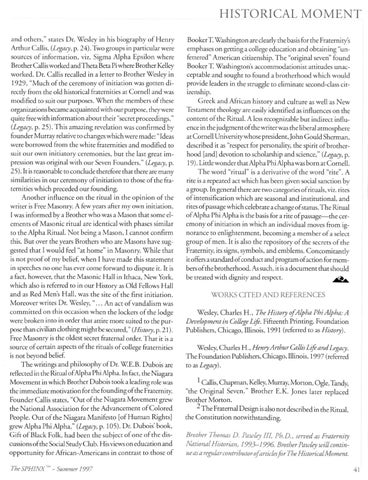HISTORICAL MOMENT and others," states Dr. Wesley in his biography of Henry Arthur Callis, {Legacy, p. 24). Two groups in particular were sources of information, viz. Sigma Alpha Epsilon where Brother Callis worked andTheta Beta Pi where Brother Kelley worked. Dr. Callis recalled in a letter to Brother Wesley in 1929, "Much of the ceremony of initiation was gotten directly from the old historical fraternities at Cornell and was modified to suit our purposes. When the members of these organizations became acquainted widi our purpose, they were quite free with information about their "secret proceedings," {Legacy, p. 25). This amazing revelation was confirmed by founder Murray relative to changes which were made: "Ideas were borrowed from the white fraternities and modified to suit our own initiatory ceremonies, but the last great impression was original with our Seven Founders," {Legacy, p. 25). It is reasonable to conclude therefore that there are many similarities in our ceremony of initiation to those of the fraternities which preceded our founding. Another influence on the ritual in the opinion of the writer is Free Masonry. A few years after my own initiation, I was informed by a Brother who was a Mason that some elements of Masonic ritual are identical with phases similar to the Alpha Ritual. Not being a Mason, I cannot confirm this. But over the years Brothers who are Masons have suggested that I would feel "at home" in Masonry. While that is not proof of my belief, when I have made this statement in speeches no one has ever come forward to dispute it. It is a fact, however, that the Masonic Hall in Ithaca, New York, which also is referred to in our History as Old Fellows Hall and as Red Men's Hall, was the site of the first initiation. Moreover writes Dr. Wesley, "... An act of vandalism was committed on this occasion when the lockers of the lodge were broken into in order that attire more suited to the purpose than civilian clothing might be secured," {History, p. 21). Free Masonry is the oldest secret fraternal order. That it is a source of certain aspects of the rituals of college fraternities is not beyond belief. The writings and philosophy of Dr. W.E.B. Dubois are reflected in the Ritual of Alpha Phi Alpha. In fact, the Niagara Movement in which Brother Dubois took a leading role was the immediate motivation for the founding of the Fraternity. Founder Callis states, "Out of the Niagara Movement grew the National Association for the Advancement of Colored People. Out of the Niagara Manifesto [of Human Rights] grew Alpha Phi Alpha," {Legacy, p. 105). Dr. Dubois' book, Gift of Black Folk, had been the subject of one of the discussions ofthe Social Study Club. His views on education and opportunity for African-Americans in contrast to those of The SPHINX™ - Summer 1997
BookerT Washington are clearly the basis for the Fraternity's emphases on getting a college education and obtaining "unfettered" American citizenship. The "original seven" found BookerT. Washington's accommodationist attitudes unacceptable and sought to found a brotherhood which would provide leaders in the struggle to eliminate second-class citizenship. Greek and African history and culture as well as New Testament theology are easily identified as influences on the content of the Ritual. A less recognizable but indirect influence in the j udgment of the writer was the liberal atmosphere at Cornell University whose president, John Gould Sherman, described it as "respect for personality, the spirit of brotherhood [and] devotion to scholarship and science," {Legacy, p. 19). Little wonder that Alpha Phi Alpha was born at Cornell. The word "ritual" is a derivative of the word "rite". A rite is a repeated act which has been given social sanction by a group. In general there are two categories of rituals, viz. rites of intensification which are seasonal and institutional, and rites ofpassage which celebrate a change ofstatus. The Ritual ofAlpha Phi Alpha is the basis for a rite of passage—die ceremony of initiation in which an individual moves from ignorance to enlightenment, becoming a member of a select group of men. It is also the repository of the secrets of the Fraternity, its signs, symbols, and emblems. Concomitantly it offers a standard of conduct and program of action for members of the brotherhood. As such, it is a document that should be treated with dignity and respect. ^fa WORKS CITED AND REFERENCES Wesley, Charles H., The History of Alp ha Phi Alpha: A Development in College Life. Fifteenth Printing. Foundation Publishers, Chicago, Illinois, 1991 (referred to as History). Wesley, Charles H., Henry Arthur Callis Life and Legacy. The Foundation Publishers, Chicago, Illinois, 1997 (referred to as Legacy). 1
Callis, Chapman, Kelley, Murray, Morton, Ogle, Tandy, "the Original Seven." Brother E.K. Jones later replaced Brother Morton. 2 The Fraternal Design is also not described in the Ritual, the Constitution notwithstanding. Brother Thomas D. Pawley III, Ph.D., served as Fraternity National Historian, 1993-1996. Brother Pawley will continue as a regular contributor of articlesforThe HistoricalMoment. 41
